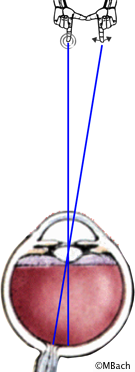
The neighboring image sequence should help you to do the right thing. [It runs only once, to restart reload the page.]
The basic observation: Your right index finger should seem to vanish at its top. If this does not occur for you,
Once you’ve discovered your blind spot, experiment a little – it’s amazingly large. Also try it for the other eye; you’ll notice that its position is mirrored.
Experiment a little more: What do you see in the blind spot? Try various backgrounds: The brain assumes “it will look like what’s outside” and invent accordingly… I have a pen that’s red at one end an blue at the other. If I place it so, that the red-blue border sits within the blind spot, what I see can only be described as puzzling. A pity that one cannot inspect it closer, since at 14° eccentricity our visual acuity is less than 1/10th compared to the center.
[BTW: The way I here depict the hands is actually impossible, they’re mirrored. When I composed the picture I started from a sign-language picture (an “L”) and never noticed the inversion until one of my daughters pointed it out to me… I left it in for fun.]

The image bottom right helps to understand that the center of the retina “looks” at the target. Slightly off-center (14° temporally, and 2° down) toward the nose is the “optic disk”, the place where all nerve fibres leave the eye, forming the optic nerve – at that location there is no room for photoreceptors, consequently creating the “blind spot” in the visual field.
Why do we not notice this amazingly large blind spot in everyday life? First, with both eyes open, the each eye’s blind spot is filled by a seeing area of the fellow eye. But why, then, do we not notice it with one eye closed? The usual answer is “filling in” – that’s just a word, the real mechanism is not well understood. This filling-in mechanism is rather “intelligent” – it fills in a background pattern, or it fills in an object passing through the blind spot. Quite amazing, really. That’s why I count it to “higher order” illusions.
The combination of outstretched arm and touching thumbs happens to end up with the correct angle (14°) for most people, since arm- and thumb lengths are correlated, nice.
At the bottom of the page I show Helmholtz’ original figure – you’re supposed to close left eye, fixate the cross and move towards the image until the white circle disappears. Indeed it vanishes completely at the right distance.
Helmholtz, Hermann von (1911) Handbuch der physiologischen Optik, Band II, Seite 24ff.
I learned the “finger wiggle” procedure from a talk given by Susana Martinez-Conde, thanks!
Tom Stafford has additional demos and literature background in his eBook
